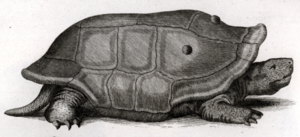Réunion giant tortoise facts for kids
Quick facts for kids Réunion giant tortoise |
|
|---|---|
 |
|
| 1792 sketch of a living specimen | |
| Conservation status | |
| Scientific classification | |
| Genus: |
Cylindraspis
|
| Species: |
indica
|
| Synonyms | |
|
|
The Reunion giant tortoise (Cylindraspis indica) was a huge tortoise that lived only on Réunion Island. This island is located in the Indian Ocean. Sadly, this amazing animal is now extinct, meaning there are none left alive today. It disappeared around the 1840s.
In the 1600s and early 1700s, there were many of these tortoises. But European sailors hunted them in large numbers. This led to their complete disappearance.
What Did the Reunion Giant Tortoise Look Like?
The Reunion giant tortoise could grow to be about 50 to 110 centimeters (20 to 43 inches) long. It was the biggest of the Cylindraspis giant tortoises found in the Mascarene Islands. Its size was similar to today's Aldabra and Galapagos giant tortoises. However, the Reunion tortoise was longer and had a more stretched-out body shape.
It had long legs and a long neck. Its head was large with strong jaws that had serrated (saw-like) edges. Males of this species were noticeably larger than females. This difference between male and female sizes is called sexual dimorphism.
These tortoises also looked quite different from each other within the same species. Some had a high, rounded shell, like a dome. Others had a shell that was flatter on top and curved up at the front and back, like a saddle.
Where Did the Reunion Giant Tortoise Live?
This tortoise lived only on Réunion Island. It was very common there and lived in huge groups. These large groups played a very important role in keeping the island's native forests healthy. They helped the forests grow and renew themselves.
Why Did the Reunion Giant Tortoise Become Extinct?
These giant tortoises were known to be very friendly and curious. They were not afraid of humans at all. This made them very easy to catch for the first people who came to the island. They were hunted in huge numbers. People would burn them to get fat and oil, or use them as food for themselves or for pigs. Many tortoises were also packed into ships to be used as food during long sea voyages.
Besides hunting, new animals brought to the island also caused problems. These were called invasive species. Pigs, cats, and rats would destroy the tortoise eggs and eat the baby tortoises (hatchlings).
By the 1700s, most of the tortoises living near the coast were gone. By 1800, it was thought that they were extinct in most parts of the island. The very last ones were seen in the highlands of Upper Cilaos. The last few tortoises survived in these high areas until the 1840s, when they finally disappeared forever.



